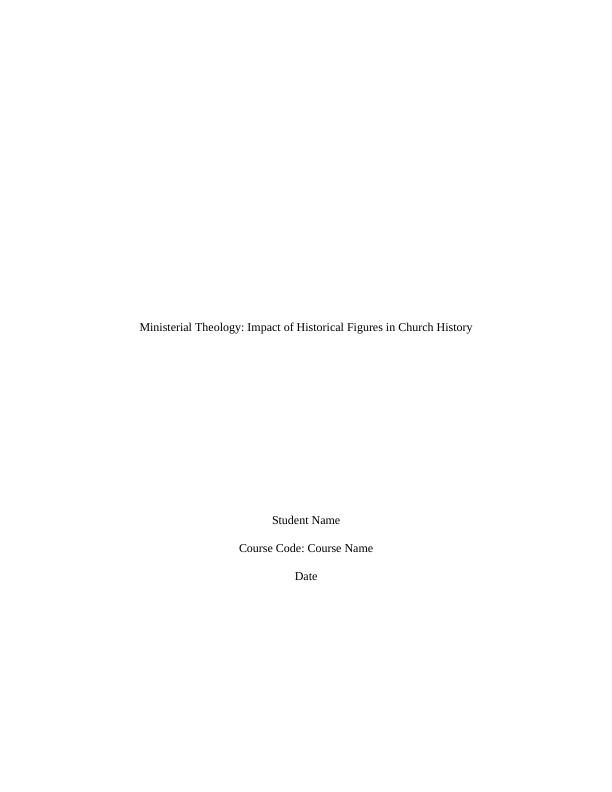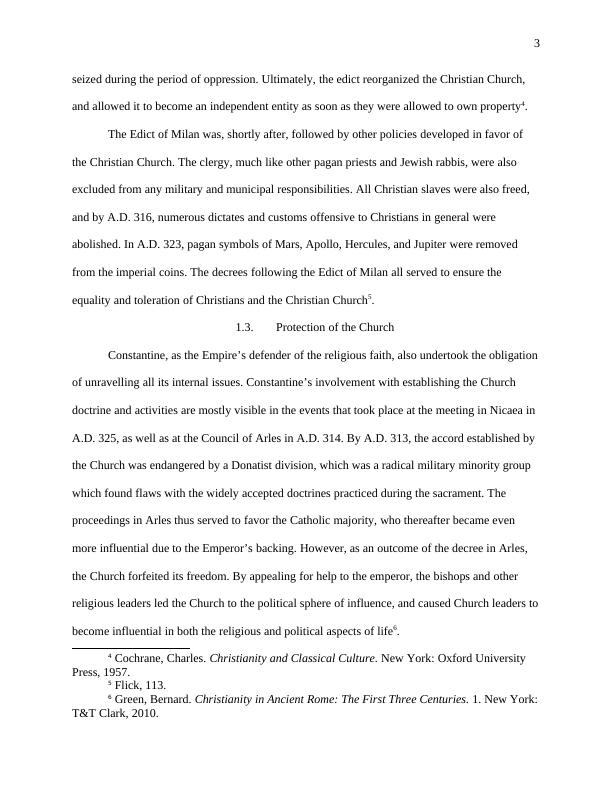Impact of Historical Figures in Church History
Added on 2023-01-19
11 Pages2971 Words54 Views
Ministerial Theology: Impact of Historical Figures in Church History
Student Name
Course Code: Course Name
Date
Student Name
Course Code: Course Name
Date

1
Due to certain critical political and historical influences which took place from A.D. 300,
the Christian Church not only found its footing, but also gained significant control of the Roman
State.1 In turn, this led to mutual dependency between the Church and several other states,
though mainly for the purpose of establishing and maintaining control over specific populations.
Consequently, the purpose of this essay is analyze the impact of Constantine, Pope Urban II, and
John Calvin as key figures in the history of the Christian Church
1. Constantine
The affiliation between the government and religion is complex, dynamic, and often
endures significant challenges for both parties. This is especially notable in the change that
occurred between A.D. 312 to 337 within the Christian Church and Roman State, at the time of
Emperor Constantine’s reign. During the first three centuries after Jesus Christ, Christians began
to garner the influence crucial in affecting religious changes in the Roman Empire.
Subsequently, towards the close of the fourth century A.D., the change took place; the initially
pagan Roman Empire unified with the Christian Church to form an ecclesiastical state. This
section focuses on Constantine’s impact on the events and policies of that period in favor of both
the state and the Christian Church. It examines how due to the Emperor’s legislative decisions,
the Roman State significantly influenced the Church2.
1.1. Supported Christianity in the Roman State
In A.D. 300, paganism was a dominant part of the government, and daily life. It was
accepted as an act of patriotism, and was celebrated nationally by a majority in the Empire. After
the demise of Constantine’s father Constantius, he became Augustusin shortly after. Shortly after
1 Flick, Alexander. The Rise of the Mediaeval Church: And Its Influence on the
Civilisation of Western Europe From the First to the Thirteenth Century. Berlin: Forgotten
Books, 2017, 112
2 Frend, W. The Rise of Christianity. Philadelphia: Philadelphia Press, 1984.
Due to certain critical political and historical influences which took place from A.D. 300,
the Christian Church not only found its footing, but also gained significant control of the Roman
State.1 In turn, this led to mutual dependency between the Church and several other states,
though mainly for the purpose of establishing and maintaining control over specific populations.
Consequently, the purpose of this essay is analyze the impact of Constantine, Pope Urban II, and
John Calvin as key figures in the history of the Christian Church
1. Constantine
The affiliation between the government and religion is complex, dynamic, and often
endures significant challenges for both parties. This is especially notable in the change that
occurred between A.D. 312 to 337 within the Christian Church and Roman State, at the time of
Emperor Constantine’s reign. During the first three centuries after Jesus Christ, Christians began
to garner the influence crucial in affecting religious changes in the Roman Empire.
Subsequently, towards the close of the fourth century A.D., the change took place; the initially
pagan Roman Empire unified with the Christian Church to form an ecclesiastical state. This
section focuses on Constantine’s impact on the events and policies of that period in favor of both
the state and the Christian Church. It examines how due to the Emperor’s legislative decisions,
the Roman State significantly influenced the Church2.
1.1. Supported Christianity in the Roman State
In A.D. 300, paganism was a dominant part of the government, and daily life. It was
accepted as an act of patriotism, and was celebrated nationally by a majority in the Empire. After
the demise of Constantine’s father Constantius, he became Augustusin shortly after. Shortly after
1 Flick, Alexander. The Rise of the Mediaeval Church: And Its Influence on the
Civilisation of Western Europe From the First to the Thirteenth Century. Berlin: Forgotten
Books, 2017, 112
2 Frend, W. The Rise of Christianity. Philadelphia: Philadelphia Press, 1984.

2
the defeat of the remaining three forerunners in the ruling Tetrarchy, Constantine only needed to
eliminate Maximin’s son Maxentius before gaining full leadership in the western region of the
empire. Maxentius’ defeat took place in A.D. 312 in the battle on the Milvian Bridge, after which
Constantine went back to Rome declaring victory in the West. This battle was particularly
significant in the history of the Church since it acted as a religious turning point for the entire
empire. It was during this battle that Constantine openly became a supporter of Christianity.
Constantine besought the help of the Christian God during all his battles, and continued to carry
the Christian emblem at the forefront of this army from one battle to the next. He continued his
dependence on the Christian God till he won all his battles, and was declared the single ruler of
the Roman Empire. As of this period, Constantine was recognized by both pagans and Christians
alike as a Christian3.
1.2. Established and Maintained Toleration of Christianity
In A.D. 313, Constantine and Licinius, who was Augustus in the East, came together to
develop a rule for religious liberality. The Edict of Milan proclaimed religious liberation in the
Roman Empire, and had a significant impact on the Christian Church. The policy not only ceased
the torment of Christians, but also equated the religion with paganism. By so doing, Christianity
became a licensed cult, and allowed Christians to practice their beliefs and convictions devoid of
any lawful ramifications. Additionally, Christians that had been previously barred from
accessing their legitimate rank of authority regained their control and rightful positions. In
general, Christians were also allowed the right to gathering, and received back any possessions
3 Gibbon, Edward. The Decline and Fall of the Roman Empire. Vol. 1. London: Strahan
& Cadell, 1789.
the defeat of the remaining three forerunners in the ruling Tetrarchy, Constantine only needed to
eliminate Maximin’s son Maxentius before gaining full leadership in the western region of the
empire. Maxentius’ defeat took place in A.D. 312 in the battle on the Milvian Bridge, after which
Constantine went back to Rome declaring victory in the West. This battle was particularly
significant in the history of the Church since it acted as a religious turning point for the entire
empire. It was during this battle that Constantine openly became a supporter of Christianity.
Constantine besought the help of the Christian God during all his battles, and continued to carry
the Christian emblem at the forefront of this army from one battle to the next. He continued his
dependence on the Christian God till he won all his battles, and was declared the single ruler of
the Roman Empire. As of this period, Constantine was recognized by both pagans and Christians
alike as a Christian3.
1.2. Established and Maintained Toleration of Christianity
In A.D. 313, Constantine and Licinius, who was Augustus in the East, came together to
develop a rule for religious liberality. The Edict of Milan proclaimed religious liberation in the
Roman Empire, and had a significant impact on the Christian Church. The policy not only ceased
the torment of Christians, but also equated the religion with paganism. By so doing, Christianity
became a licensed cult, and allowed Christians to practice their beliefs and convictions devoid of
any lawful ramifications. Additionally, Christians that had been previously barred from
accessing their legitimate rank of authority regained their control and rightful positions. In
general, Christians were also allowed the right to gathering, and received back any possessions
3 Gibbon, Edward. The Decline and Fall of the Roman Empire. Vol. 1. London: Strahan
& Cadell, 1789.

3
seized during the period of oppression. Ultimately, the edict reorganized the Christian Church,
and allowed it to become an independent entity as soon as they were allowed to own property4.
The Edict of Milan was, shortly after, followed by other policies developed in favor of
the Christian Church. The clergy, much like other pagan priests and Jewish rabbis, were also
excluded from any military and municipal responsibilities. All Christian slaves were also freed,
and by A.D. 316, numerous dictates and customs offensive to Christians in general were
abolished. In A.D. 323, pagan symbols of Mars, Apollo, Hercules, and Jupiter were removed
from the imperial coins. The decrees following the Edict of Milan all served to ensure the
equality and toleration of Christians and the Christian Church5.
1.3. Protection of the Church
Constantine, as the Empire’s defender of the religious faith, also undertook the obligation
of unravelling all its internal issues. Constantine’s involvement with establishing the Church
doctrine and activities are mostly visible in the events that took place at the meeting in Nicaea in
A.D. 325, as well as at the Council of Arles in A.D. 314. By A.D. 313, the accord established by
the Church was endangered by a Donatist division, which was a radical military minority group
which found flaws with the widely accepted doctrines practiced during the sacrament. The
proceedings in Arles thus served to favor the Catholic majority, who thereafter became even
more influential due to the Emperor’s backing. However, as an outcome of the decree in Arles,
the Church forfeited its freedom. By appealing for help to the emperor, the bishops and other
religious leaders led the Church to the political sphere of influence, and caused Church leaders to
become influential in both the religious and political aspects of life6.
4 Cochrane, Charles. Christianity and Classical Culture. New York: Oxford University
Press, 1957.
5 Flick, 113.
6 Green, Bernard. Christianity in Ancient Rome: The First Three Centuries. 1. New York:
T&T Clark, 2010.
seized during the period of oppression. Ultimately, the edict reorganized the Christian Church,
and allowed it to become an independent entity as soon as they were allowed to own property4.
The Edict of Milan was, shortly after, followed by other policies developed in favor of
the Christian Church. The clergy, much like other pagan priests and Jewish rabbis, were also
excluded from any military and municipal responsibilities. All Christian slaves were also freed,
and by A.D. 316, numerous dictates and customs offensive to Christians in general were
abolished. In A.D. 323, pagan symbols of Mars, Apollo, Hercules, and Jupiter were removed
from the imperial coins. The decrees following the Edict of Milan all served to ensure the
equality and toleration of Christians and the Christian Church5.
1.3. Protection of the Church
Constantine, as the Empire’s defender of the religious faith, also undertook the obligation
of unravelling all its internal issues. Constantine’s involvement with establishing the Church
doctrine and activities are mostly visible in the events that took place at the meeting in Nicaea in
A.D. 325, as well as at the Council of Arles in A.D. 314. By A.D. 313, the accord established by
the Church was endangered by a Donatist division, which was a radical military minority group
which found flaws with the widely accepted doctrines practiced during the sacrament. The
proceedings in Arles thus served to favor the Catholic majority, who thereafter became even
more influential due to the Emperor’s backing. However, as an outcome of the decree in Arles,
the Church forfeited its freedom. By appealing for help to the emperor, the bishops and other
religious leaders led the Church to the political sphere of influence, and caused Church leaders to
become influential in both the religious and political aspects of life6.
4 Cochrane, Charles. Christianity and Classical Culture. New York: Oxford University
Press, 1957.
5 Flick, 113.
6 Green, Bernard. Christianity in Ancient Rome: The First Three Centuries. 1. New York:
T&T Clark, 2010.

End of preview
Want to access all the pages? Upload your documents or become a member.
Related Documents
Constantine the Great | Docxlg...
|4
|739
|185
Invitation to Sociology- Assignmentlg...
|9
|1878
|10
Early Medieval Europe Assignment 2022lg...
|4
|569
|21
Comparison of Byzantium, Islam and Western Civilization & Causes, Characteristics and Effects of Medieval Crusadeslg...
|7
|2128
|300
